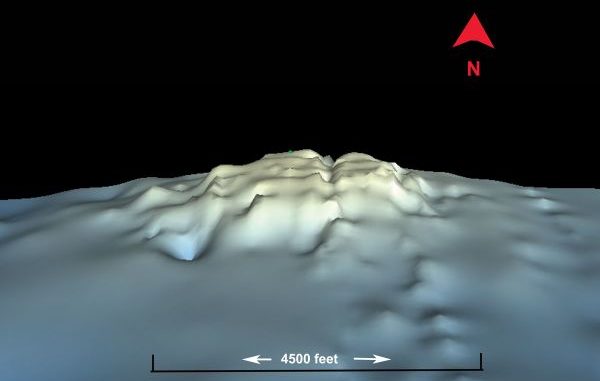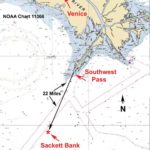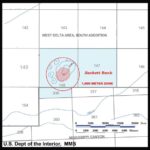
Time to plan a trip to the Midnight Lump
Dear Capt. Paul:
I have heard of a place called the Midnight Lump out of Venice that is supposed to be a great spot for line-breaking tuna and other big sport fishing, but I can’t find the location on any on my charts or maps.
Are the lumps protruding above the water surface or are they just underwater features? If they are only under water, how do you anchor around them?
Will 200 feet of anchor line be enough?
Thanks, John
Capt. Paul’s response:
Most maps and charts will not show a feature named “the Midnight Lump.”
The official name of the Midnight Lump is the Sackett Bank. And, yes, it is a draw for tuna and wahoo during certain times of the year.
It is located southwest of the mouth of Southwest Pass of the Mississippi River. NOAA chart No. 11316A-Leased blocks, Miss River to Galveston shows the Lump as well as the entrance to SW Pass, as does Chart 11366.
As shown on the chart, it is located in Leased Block 148 of the South Addition of the West Delta Leased Area. (148-WD)
The Midnight Lump has become very popular in recent decades. On prime fishing days, there can be more than 100 boats working the area. So planning and getting an early start is imperative.
On off days or weekdays the crowd is usually smaller.
Once there, courtesy and proper angler etiquette is mandatory.
You will need a deepwater depth finder to actually find and “see” the exact location of the Lump. A recording depth finder designed for deep salt water is ideal; if you can, record the depth finder images for future use.
The seabed around the Lump is about 60-plus fathoms (360 feet) deep. The depth over the top of the Lump is about 33 fathoms (198 feet).
Picture several inverted, truncated cones rising from the seabed. Although there are several such underwater mounds in the one-mile diameter, the total area is called “the Midnight Lump.”
The fishing around the Lump is good because Gulf currents push water over the tops of the features, causing smaller baitfish to be pushed against and over the protrusions.
So amberjack, tuna, marlin, snapper, grouper and wahoo usually gather there to eat their fill.
Usually, fishing one side of the lump is better than the other. You will have to play that by ear, as the prevailing currents and weather determine which side of the lump is best.
I plotted the approximate center of the Midnight Lump at or about 28° 38.122’ N. Lat ~ 89° 33.249’ W. Long. Remember, this is the center of an area that is about a mile in diameter. That is why you will need your depth finder.
The location is about 20.2 miles from the Southwest Pass of the Mississippi River at a position near the light house (near land’s end) at a bearing of 202 degrees magnetic. That makes it about 19.4 miles at a bearing of 203 degrees magnetic from the green No. 1 gong buoy in the lower part of the Southwest Pass channel.
It is also about 35.2 miles at a bearing of 192 degrees magnetic from the end of the breakwater (29°08.233’ N. Latitude ~ 89° 26. 184’ W. Longitude) at Tiger Pass.
No, 200 feet of anchor line will not do the job. Bring more anchor line, as you will need every foot of it.
Most anglers suggest a minimum of 600 feet of anchor line with anywhere from 10 to 30 feet of chain. The chain will greatly enhance your anchor’s ability to set.
Your anchor size will vary greatly, but a medium-sized vessel (23 to 28 feet) should use at least a 22- to 25-pound anchor.
A line marked at 100, 150, 200, 250, 300, 350, 400, 450, 500 and 550 feet will be an aid in determining how much line you have out. And, of course, you will need someone with a strong back or an anchor windless.
Some captains suggest an anchor point on the Lump at about 250 feet deep.
Be sure to bring all of your courtesy and a lot of patience, as you will be competing for an anchorage and your fishing lines might cross with other anglers in the same area.
And be prepared to sacrifice your terminal tackle because of the Lump itself and because of other anglers.
The normal big-fish baits are productive, but sometimes a line with a heavy sinker and bait about 10 feet above the sinker will also work.
Sometimes it is better to just cut the line rather than interfere with an angler with a fish on line.
Caution should be used as this position is at least over 20 miles offshore from the beginning of the Southwest Pass channel and the boater must navigate the Mississippi River, a run of about 30 miles from Venice — making it at least a 50-mile trip one way to the Lump.
Remember: This section of the Mississippi River is the busiest part of the River and you might have to give way to some of the larger ocean-going vessels. The site is very near to the main entrance routes to the river.
The route to the Midnight Lump is not recommended for inexperienced boats or boats that are not seaworthy for this type of trip.
If you intend to make such a trip, be sure to leave a float plan with a friend or relative who will remain on shore, and be certain to have a reliable VHF Marine radio, as cell phones are useless that far out.
Either way, you will experience a trip that will be at least over 100 miles. You will need enough fuel for at least a 150- to 160-mile trip. Can your rig tote that much fuel?
As for anchoring around the Lump, I can’t say it any better than Capt. Robert in one of his posts on the LouisianaSportsman.com forum”
“Look at the big picture here, my man,” the captain wrote. “If you mess up any one part, then you mess up everything and (you) won’t get a good hold.
“First off, a lot of people use line that is too heavy for their boat. If you go overkill here thinking stronger is better you are shooting yourself in the foot. The anchor rope won’t stretch as you bob up and down, and it will drag the anchor. (The anchor rope) needs to be at least 600 feet, but carry an extra three coils of 600 feet — it is a great idea. Use three-strand, not double braid. Double braided doesn’t stretch as much.
“The anchor itself — they’re not all the same. One of the best is a Fortress anchor. Don’t be fooled: Many look like it but they don’t hold like it (it’s pricey but worth every penny). A 7-pound Fortress outperforms a 20-pound Danforth anchor big-time.
“About the chain, a good rule of thumb: a half foot of chain for every foot of boat. Remember what I said: If you mess up the other parts here (i.e. too strong a rope, not enough rope or not a good anchor) you will need more chain. Don’t read this as ‘OK, I’ll just get a bunch of chain and screw the rest.’ No, no, no!”
“P.S. Don’t forget the anchor ball. Most people use the steel ring, but there is a better product with a clutch in it that won’t let the anchor fall back down (which it will do if you don’t get the flukes hanging in the ring).
“Also, don’t just throw it over the side and cross your fingers: It will sail off and foul itself on the way down. Ease her out slowly. When she catches, keep letting out (line) for what will seem a long time — let it out slowly. When you think it’s 600 feet or more out, tie it off and make sure you’re holding good. It is a good idea to mark the line with the depths prior to actually using it.
“Don’t forget to tie a float to the end of the line so you can ditch it for a big fish. The float needs to be big enough to keep the anchor ball from sliding off (because it will). OK, it’s that easy. If you ain’t sweating you ain’t fishing the Lump right.”
If you are interested in fishing the Lump, now is the time to start your planning. Good luck fishing.
All positions are stated as ddd, mm.mmm and were determined using WGS 84 Datum. All bearings are stated in Magnetic degrees and are shown as statute miles.
Capt. Paul



